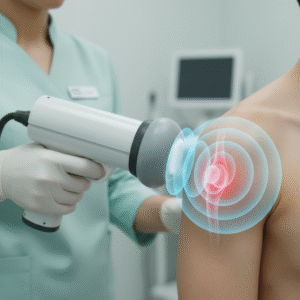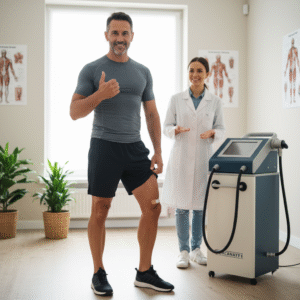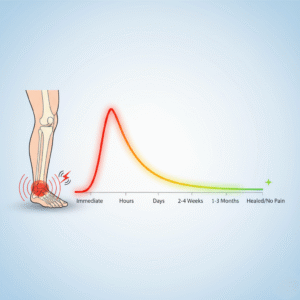When undergoing Extracorporeal Shock Wave Therapy (ESWT), it’s natural to wonder how your body will respond after the session. One of the most common questions patients ask is, “How long does the pain last after shockwave therapy?” The short answer is: some discomfort is normal for a brief period, and the healing process varies depending on the individual and the condition being treated.
This guide breaks down what to expect after your appointment, why pain may occur, and practical tips for easing post-treatment soreness so you can recover comfortably and confidently.
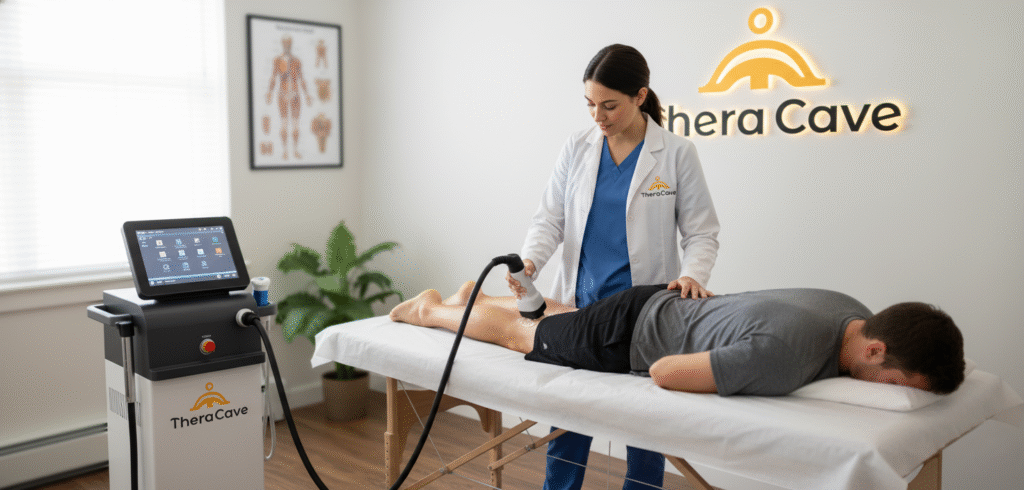
Understanding What Happens During Shockwave Therapy
Shockwave therapy is a non-invasive treatment that uses acoustic waves to stimulate healing in injured tissues. It’s often recommended for conditions like:
- Plantar fasciitis
- Tendonitis (including rotator cuff and Achilles tendon)
- Calcific shoulder pain
- Muscle trigger points and chronic soft tissue injuries
The acoustic energy increases blood flow, breaks down scar tissue, and encourages the body’s natural repair mechanisms. While effective, the treatment can temporarily irritate the area, which is why mild pain or soreness afterward is common.
How Long Does Pain Usually Last After Shockwave Therapy?
Most people experience mild to moderate pain or soreness for 24 to 72 hours after their session. This discomfort typically feels similar to post-workout muscle soreness and gradually eases without medical intervention.
- First 24 Hours: Mild tenderness, swelling, or bruising may occur around the treated area.
- 48 Hours After: Some patients notice peak soreness during this period, especially if the treated tissue is deep or inflamed.
- 72 Hours and Beyond: Pain usually subsides, leaving behind only slight sensitivity.
A small percentage of people may experience lingering discomfort for up to 5 days. This usually happens if the treatment was applied to a chronic injury site or if your body’s inflammatory response is more sensitive.
Why Pain Happens After the Session
Pain after shockwave therapy isn’t necessarily a bad sign; it’s often part of the healing process. Here’s why it occurs:
- Increased Blood Flow: The waves increase circulation, which can make tissues more sensitive in the short term.
- Inflammatory Response: Shockwaves create microtrauma that triggers your body’s natural repair process.
- Breakdown of Adhesions: Scar tissue or calcifications may break down, causing temporary soreness.
- Nerve Stimulation: Some discomfort comes from temporary nerve irritation, which fades as tissues recover.
Managing Pain After Shockwave Therapy
You don’t need to “tough out” discomfort after the session. With a few simple steps, you can ease soreness and support healing:
1. Rest the Treated Area
Avoid strenuous activities or high-impact movements for at least 48 hours. This allows your body to repair tissues without additional strain.
2. Ice (If Needed)
If swelling or tenderness is noticeable, apply a cold pack wrapped in a towel for 10–15 minutes at a time. Ice can help numb discomfort and control inflammation.
3. Avoid Anti-Inflammatory Medications
Unless prescribed by your healthcare provider, it’s generally recommended to avoid NSAIDs (like ibuprofen) for a few days. The inflammation triggered by shockwave therapy supports healing, and suppressing it may slow progress.
4. Stay Hydrated
Hydration helps flush out cellular waste and supports tissue repair.
5. Gentle Stretching or Mobility Exercises
After a couple of days, light movements can promote circulation and flexibility, just don’t push through pain.
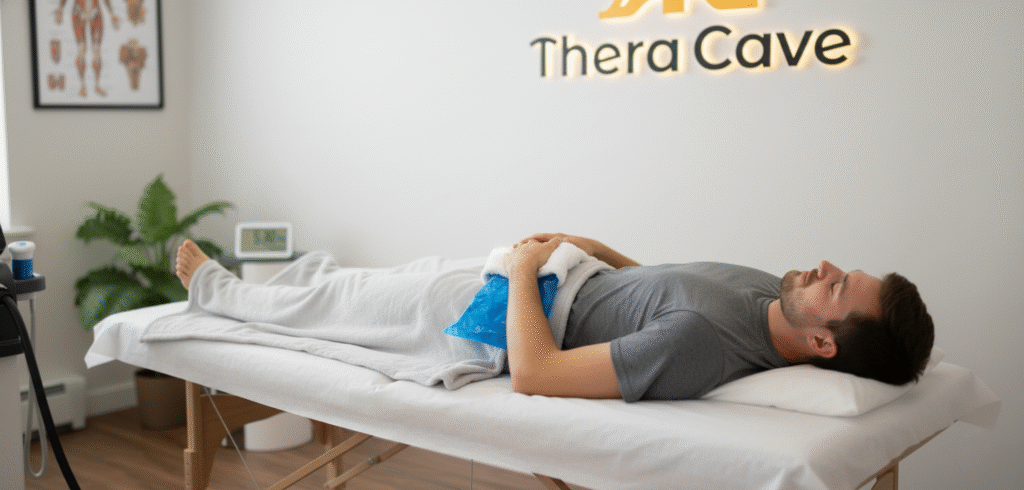
When Pain Might Last Longer
If pain lasts longer than 5–7 days or worsens significantly, it’s best to consult your provider. Prolonged discomfort can be caused by:
- Overuse of the treated area too soon
- A strong inflammatory response
- An underlying condition requiring additional treatment
Your provider may recommend adjusting the intensity of future sessions or pairing shockwave therapy with other supportive treatments like physical therapy.
What Not to Do After Shockwave Therapy
To get the best results and minimize pain duration:
- Don’t exercise intensely within the first 48 hours
- Don’t apply heat immediately after treatment
- Don’t self-medicate with strong painkillers or NSAIDs unless directed
- Don’t ignore worsening pain or swelling
How Shockwave Therapy Fits Into a Larger Recovery Plan
Shockwave therapy is often part of a comprehensive treatment plan. While pain can occur after the session, it’s typically short-lived and a sign your body is responding to the treatment.
Many patients notice significant improvement after 3–5 sessions, with pain decreasing and mobility increasing over time. The short recovery window is one of the reasons shockwave therapy is favored over surgical interventions for chronic soft tissue injuries.
Patient Experience: What People Typically Report
While every person heals differently, here’s what many patients share after their sessions:
- “It felt sore the next day, like a good workout.”
- “I was tender for two days, but then the pain went away and my range of motion improved.”
- “It’s not pain-free, but it’s manageable and definitely worth the results.”
This mild, temporary discomfort is often outweighed by the long-term pain relief shockwave therapy provides.
Final Thoughts: Temporary Pain, Long-Term Gain
So, how long does pain last after shockwave therapy? Usually just a few days. This discomfort is a normal part of the healing process, and with proper care, it fades quickly.
Call to Action
The key to maximizing results is listening to your body, following aftercare guidelines, and communicating openly with your therapist. Whether you’re treating chronic heel pain, tendonitis, or another musculoskeletal condition, this therapy offers a powerful, non-invasive solution that can help restore mobility and reduce pain over time. Contact us today!

